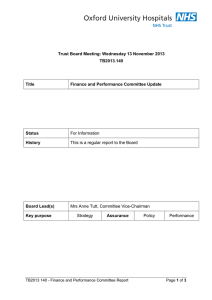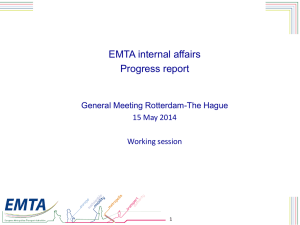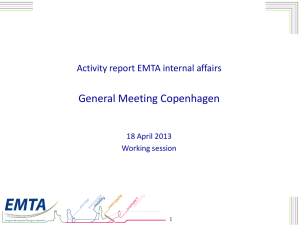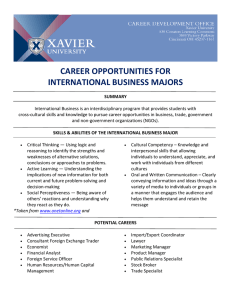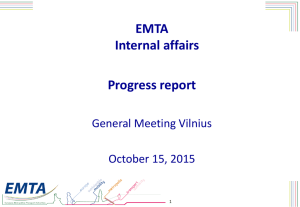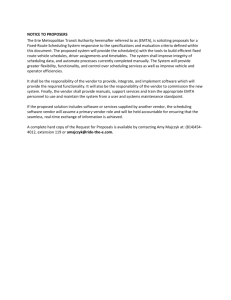DSP-based Puma-4 Architecture for eMTA
advertisement
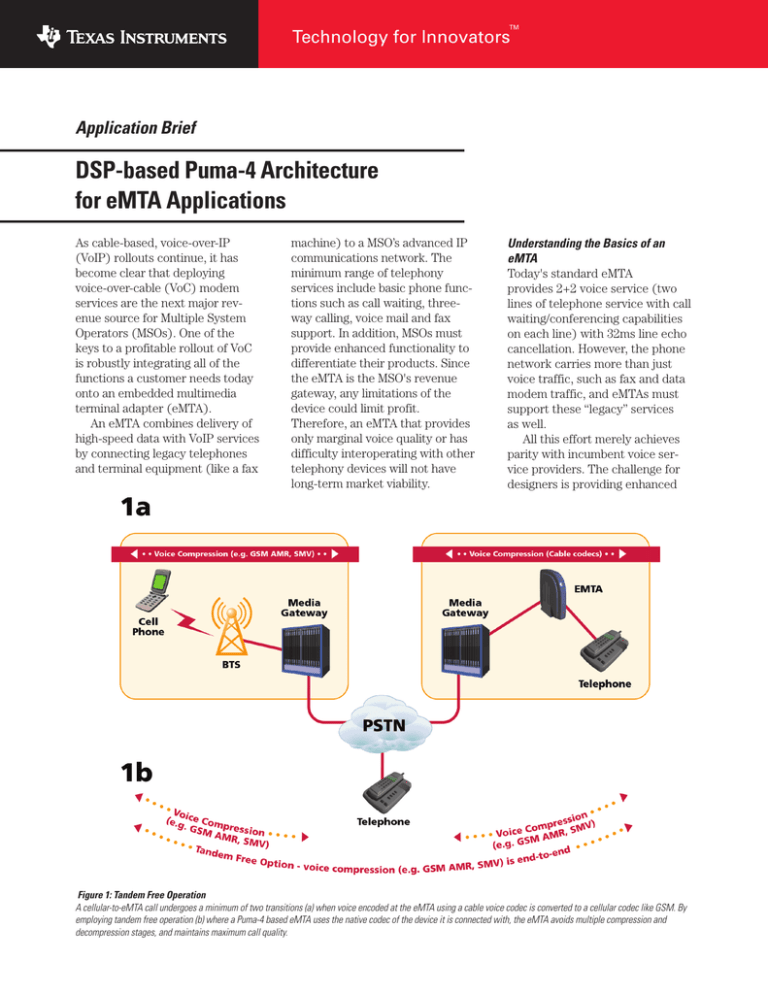
TM Technology for Innovators Application Brief DSP-based Puma-4 Architecture for eMTA Applications As cable-based, voice-over-IP (VoIP) rollouts continue, it has become clear that deploying voice-over-cable (VoC) modem services are the next major revenue source for Multiple System Operators (MSOs). One of the keys to a profitable rollout of VoC is robustly integrating all of the functions a customer needs today onto an embedded multimedia terminal adapter (eMTA). An eMTA combines delivery of high-speed data with VoIP services by connecting legacy telephones and terminal equipment (like a fax machine) to a MSO’s advanced IP communications network. The minimum range of telephony services include basic phone functions such as call waiting, threeway calling, voice mail and fax support. In addition, MSOs must provide enhanced functionality to differentiate their products. Since the eMTA is the MSO's revenue gateway, any limitations of the device could limit profit. Therefore, an eMTA that provides only marginal voice quality or has difficulty interoperating with other telephony devices will not have long-term market viability. Understanding the Basics of an eMTA Today's standard eMTA provides 2+2 voice service (two lines of telephone service with call waiting/conferencing capabilities on each line) with 32ms line echo cancellation. However, the phone network carries more than just voice traffic, such as fax and data modem traffic, and eMTAs must support these “legacy” services as well. All this effort merely achieves parity with incumbent voice service providers. The challenge for designers is providing enhanced Figure 1: Tandem Free Operation A cellular-to-eMTA call undergoes a minimum of two transitions (a) when voice encoded at the eMTA using a cable voice codec is converted to a cellular codec like GSM. By employing tandem free operation (b) where a Puma-4 based eMTA uses the native codec of the device it is connected with, the eMTA avoids multiple compression and decompression stages, and maintains maximum call quality. features beyond the minimum functional requirements in order to differentiate their products while managing cost. It is important to remember that in addition to potential cost savings, eMTAs need to provide more than the minimum set of telephony services to provide differentiation over the PSTN service offerings. An improved user experience will provide additional motivation for customers to switch off the PSTN and switch on VoIP. Voice and the Puma-4 based eMTA In the telephony world, each time a voice packet is translated from one codec format to a second format (a process called transcoding), voice quality is degraded. A call between a cell phone and eMTA undergoes at minimum two transitions (see Figure 1a) when packets are converted from/to GSM and to/from G.729. Compression is lossy, and the more transitions there are – especially as calls pass through different service providers and networks – the overall quality is reduced. Adoption rates of eMTA services will be negatively impacted if users perceive a loss of quality compared to existing PSTN services. As an alternative, to avoid transcoding losses, Puma-4 based eMTAs have an opportunity to eliminate the use of codecs in tandem (see Figure 1b). Instead of compressing all voice traffic using a limited variety of cable-centric codecs that are transcoded at network media gateways, Puma-4 eMTAs can increase call quality by supporting the native codecs of the devices with which they interact. For example, when connected with a mobile device, the Puma-4 could shift from a G.729 codec to the GSM-AMR codec used natively by the cell phone. In this way, transcoding is eliminated as are all associated losses in quality, and the eMTA can enjoy a quality advantage over legacy telephone service. By accommodating multiple end devices, Puma-4 guarantees the highest call quality possible. By negotiating directly with the cell phone rather than the media gateways between them, the Puma-4 is able to select the best codec. The Architecture of an eMTA An eMTA architecture is comprised of four main subsystems: DOCSIS cable modem, application processor, VoC processor and an analog subsystem. Typically, the cable modem and application processor can be implemented on the same processor integrated with the appropriate peripherals. VoC processing should be implemented using a programmable device so that the eMTA can be upgraded as new standards, codecs and services become available. For VoC processing, DSPs offer superior performance over general purpose processors (GPP) like MPUs and MCUs. Execution of the critical loop in a voice codec uses significantly fewer cycles when implemented on a DSP because of inherent efficiencies in DSP architectures, including highly parallelized pipelines, an optimized instruction set and specialized compute units. Newer DSP architectures such as TI’s Puma-4 platform, based on the TMS320C55x™ DSP processor, support two multiply-accumulates in one cycle with no penalty due to the extra memory access required to support this enhancement. This gives a boost to the MAC-intense code that dominates the processing requirements. ® Since DSPs like TI’s C55x™ processor have a complex instruction set with dense encoding, the code size required to accomplish the same task is about 1.5 to two times less than on a GPP. This results in smaller instruction cache size and less penalty when accessing slow external memories, which in turn gives higher performance at reduced cost. In GPPs, architectures are not optimized in the same way as a DSP, resulting in two to three times more CPU cycles to accomplish similar signal processing tasks. Put another way, it takes a GPP running at 450 MHz to execute the equivalent processing on processors tuned for digital signal processing running at 150 MHz. Note that the limiting factor in implementing extended features is available headroom. Processor cost does not increase linearly with clock speed, so a GPP with more headroom will increase in cost faster than an equivalent DSP. Additionally, if a processor is already at its maximum clock speed, it has no headroom available. In some GPPs, it is possible to extend the instruction set to improve signal processing performance. Such extensions do not solve the fundamental problem of multiple access per cycle. They require design and verification effort and are usually not optimal in power, area or performance because they are not integral to the processor pipeline. Quality is Key Improving quality is a never-ending challenge for designers and end equipment manufacturers. For years, PCM has been a key codec for telephony applications because it provides high voice quality, ensures interoperability and requires little processing overhead. The primary problem with PCM is its cost in terms of bandwidth. G.711 PCM requires 64 kbps per channel, compared to a low bit rate codec (LBRC) like G.729, which provides sufficient voice quality at a bit rate as low as 8 kbps. In economic terms, one can support eight calls of G.729 for every call of G.711. While conserving network bandwidth and significantly lowering network operational costs, LBRCs require more processing resources on the eMTA. Typical eMTA configurations today allocate an LBRC for main line use and use PCM for conferencing/call waiting services. Puma-4, with its integrated DSP, provides a costeffective means for enabling an eMTA to support 2+2 operation using LBRCs for both the main line voice service as well as for the conferencing/call waiting services, enabling maximum bandwidth efficiency. Reliability, Dependability For an eMTA to become the sole piece of telephony equipment at the customer premise, it must provide the same guaranteed dial-up service during loss of power to the home that PSTNbased phones provide. Without power, a voice-enabled cable modem will not complete calls. Guaranteed service can be maintained through the addition of a battery pack and corresponding charging/monitoring circuitry. Providing battery backup is a key requirement if MSOs want to offer a true Local Exchange Carrier (LEC) service. Battery backup guarantees service availability and also allows the eMTA to remain operational during momentary power events such as brownouts or power spikes. While power events are not typical, they must be handled eloquently. Designing with low power consumption in mind will improve the reliability of an eMTA during extended power events. For signal processing functions, DSPs have significant power efficiency advantages over GPPs because GPPs must be clocked at a higher frequency to achieve the equivalent processing on a DSP. Clocking at a higher frequency results in a corresponding increase in power consumption and lower overall battery life, or increased battery cost to achieve the same battery life. Puma-4, with its integrated DSP, is optimized for battery life. The Converged Home Network Integrating wireless LAN (WLAN) within the eMTA provides a foundation for exciting new home networking applications. Broadband-enabled phones will support high-quality audio, live video streaming, full-speed web access, automatic and instantaneous synchronization with address books and e-mail services, and real-time Internet gaming. An eMTA's ability to support voice-over-WLAN also enables convergence of the cable and cellular networks. Users will use the traditional cellular network when they are mobile and access robust, higher quality voice service over the cable broadband IP network when they are home or at the office, all using the same dualmode cellular/Wi-Fi® handset. The value proposition from such convergence promises to have far-ranging impact. Cellularover-cable modem will offload residential tower demand. Cellular/ landline convergence will also enable subscribers to collapse their phone service to a single number that can reach them at the office, home, or on the road, with automatic find-me/follow-me, a single voice mailbox and dialing directory, and other enhanced services. Ultimately, these features mean less churn and higher revenues for MSOs because they are now able to claim a portion of a consumer's cellular budget they have never had access to. Carriers have begun to plan exciting service deployments that will launch as yet unrealized revenue streams. Convergence visions aside, what matters most when you consider the viability of a product is its overall cost. A flexible architecture with the right level of integration – one that allows you to optimize performance through a product family as well as your next-generation design - is essential to enabling future expandability without costburdening your current design. In this way, you can successfully balance the feature requirements of today with the as yet unknown demands of tomorrow. TI Worldwide Technical Support Internet TI Semiconductor Product Information Center Home Page support.ti.com TI Semiconductor KnowledgeBase Home Page support.ti.com/sc/knowledgebase Product Information Centers Americas Asia Phone Fax Internet/Email +1(972) 644-5580 +1(972) 927-6377 support.ti.com/sc/pic/americas.htm Europe, Middle East, and Africa Phone Belgium (English) Finland (English) France Germany Israel (English) Italy Netherlands (English) Russia Spain Sweden (English) United Kingdom Fax Internet +32 (0) 27 45 54 32 +358 (0) 9 25173948 +33 (0) 1 30 70 11 64 +49 (0) 8161 80 33 11 1800 949 0107 800 79 11 37 +31 (0) 546 87 95 45 +7 (0) 95 363 4824 +34 902 35 40 28 +46 (0) 8587 555 22 +44 (0) 1604 66 33 99 +(49) (0) 8161 80 2045 support.ti.com/sc/pic/euro.htm Japan Fax International Domestic +81-3-3344-5317 0120-81-0036 Internet/Email International support.ti.com/sc/pic/japan.htm Domestic www.tij.co.jp/pic Phone International +886-2-23786800 Domestic Toll-Free Number Australia 1-800-999-084 China 800-820-8682 Hong Kong 800-96-5941 India +91-80-51381665 (Toll) Indonesia 001-803-8861-1006 Korea 080-551-2804 Malaysia 1-800-80-3973 New Zealand 0800-446-934 Philippines 1-800-765-7404 Singapore 800-886-1028 Taiwan 0800-006800 Thailand 001-800-886-0010 886-2-2378-6808 Fax Email tiasia@ti.com or ti-china@ti.com Internet support.ti.com/sc/pic/asia.htm Important Notice: The products and services of Texas Instruments Incorporated and its subsidiaries described herein are sold subject to TI’s standard terms and conditions of sale. Customers are advised to obtain the most current and complete information about TI products and services before placing orders. TI assumes no liability for applications assistance, customer’s applications or product designs, software performance, or infringement of patents. The publication of information regarding any other company’s products or services does not constitute TI’s approval, warranty or endorsement thereof. Technology for Innovators, the black/red banner and TMS320C55x are trademarks of Texas Instruments. DOCSIS is a registered trademark of Cable Television Laboratories, Inc. Wi-Fi is a registered certification mark of the Wi-Fi Alliance. © 2005 Texas Instruments Incorporated Printed in U.S.A. Printed on recycled paper A091905 SPAT157 IMPORTANT NOTICE Texas Instruments Incorporated and its subsidiaries (TI) reserve the right to make corrections, modifications, enhancements, improvements, and other changes to its products and services at any time and to discontinue any product or service without notice. Customers should obtain the latest relevant information before placing orders and should verify that such information is current and complete. All products are sold subject to TI’s terms and conditions of sale supplied at the time of order acknowledgment. TI warrants performance of its hardware products to the specifications applicable at the time of sale in accordance with TI’s standard warranty. Testing and other quality control techniques are used to the extent TI deems necessary to support this warranty. Except where mandated by government requirements, testing of all parameters of each product is not necessarily performed. TI assumes no liability for applications assistance or customer product design. Customers are responsible for their products and applications using TI components. To minimize the risks associated with customer products and applications, customers should provide adequate design and operating safeguards. TI does not warrant or represent that any license, either express or implied, is granted under any TI patent right, copyright, mask work right, or other TI intellectual property right relating to any combination, machine, or process in which TI products or services are used. Information published by TI regarding third-party products or services does not constitute a license from TI to use such products or services or a warranty or endorsement thereof. Use of such information may require a license from a third party under the patents or other intellectual property of the third party, or a license from TI under the patents or other intellectual property of TI. Reproduction of information in TI data books or data sheets is permissible only if reproduction is without alteration and is accompanied by all associated warranties, conditions, limitations, and notices. Reproduction of this information with alteration is an unfair and deceptive business practice. TI is not responsible or liable for such altered documentation. Resale of TI products or services with statements different from or beyond the parameters stated by TI for that product or service voids all express and any implied warranties for the associated TI product or service and is an unfair and deceptive business practice. TI is not responsible or liable for any such statements. Following are URLs where you can obtain information on other Texas Instruments products and application solutions: Products Applications Amplifiers amplifier.ti.com Audio www.ti.com/audio Data Converters dataconverter.ti.com Automotive www.ti.com/automotive DSP dsp.ti.com Broadband www.ti.com/broadband Interface interface.ti.com Digital Control www.ti.com/digitalcontrol Logic logic.ti.com Military www.ti.com/military Power Mgmt power.ti.com Optical Networking www.ti.com/opticalnetwork Microcontrollers microcontroller.ti.com Security www.ti.com/security Mailing Address: Telephony www.ti.com/telephony Video & Imaging www.ti.com/video Wireless www.ti.com/wireless Texas Instruments Post Office Box 655303 Dallas, Texas 75265 Copyright 2006, Texas Instruments Incorporated
